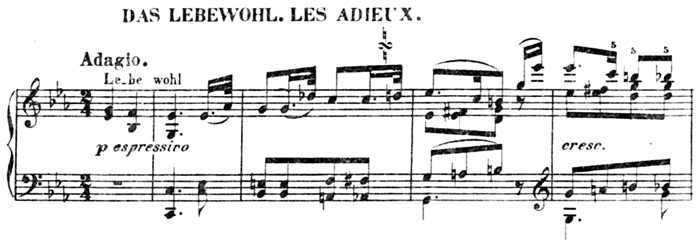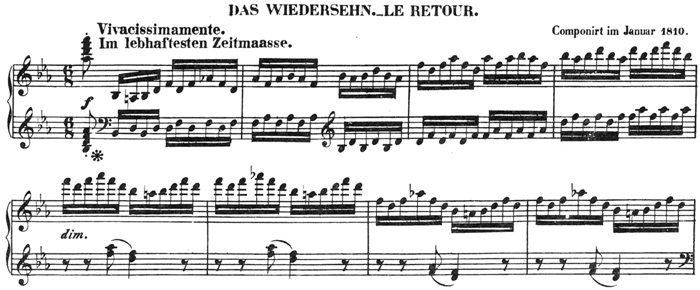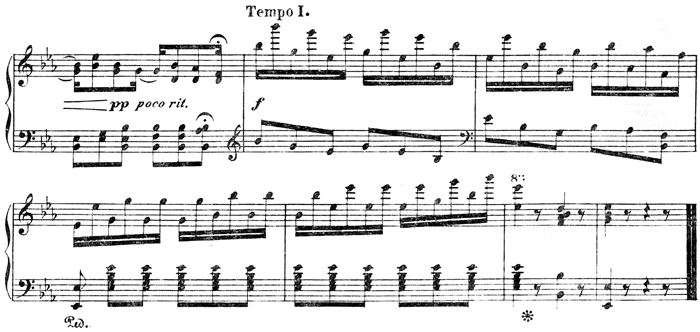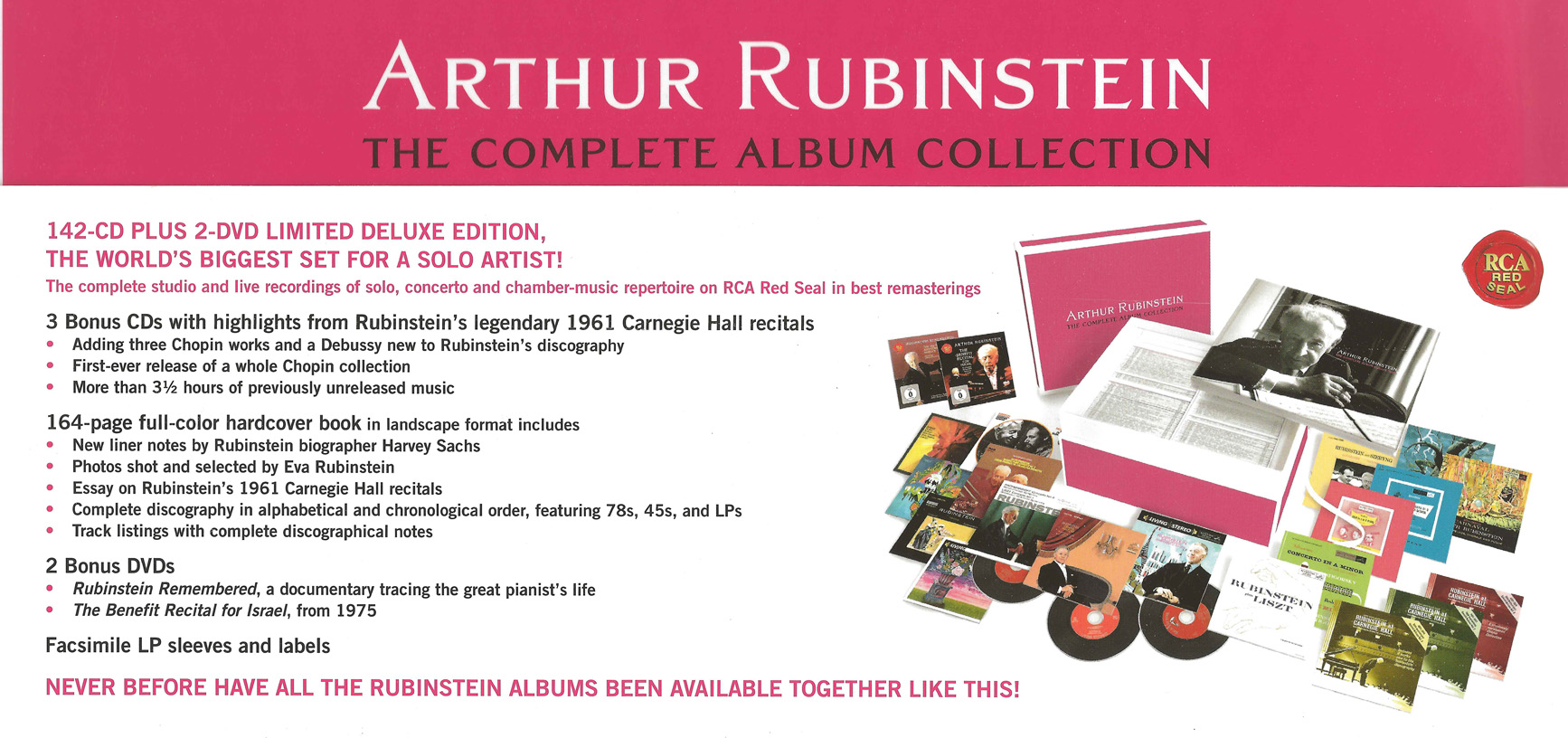Ludwig van Beethoven
Piano Sonata No.26 in E♭ major, op.81a, “Les Adieux”
Media Review / Comparison
2015-07-25 — Original posting
2015-08-20 — Added reference to Brautigam’s complete sonata recording
2016-08-05 — Brushed up for better readability
2017-09-18 — Added recording with Mélodie Zhao
2022-07-02 — Corrected recording date for Artur Schnabel
Table of Contents
- Introduction / The Recordings
- Background, About the Composition
- The Interpretations, Overview
- The Interpretations, Detail
- Wilhelm Backhaus (1961)
- Paul Badura-Skoda (1969)
- Daniel Barenboim (1984)
- Ronald Brautigam (2007)
- Emil Gilels (1974)
- Friedrich Gulda (1967)
- Arthur Rubinstein (1940) — Arthur Rubinstein Collection, CDs #11 – 14
- Arthur Rubinstein (1962) — Arthur Rubinstein Collection, CD #82
- Artur Schnabel (1933)
- Mélodie Zhao (2013)
- Addendum 1
- Addendum 2
Introduction / The Recordings
This posting is one of a series covering the recordings of Beethoven’s piano sonatas in my music collection, about the Piano Sonata No.26 in E♭ major, op.81a, “Les Adieux”. References to the CDs are given in the respective section or in one of the related postings. For links to all related postings see “Beethoven: Piano Sonatas, Summary“. I currently have the following recordings, shown here sorted by recording date:
- Artur Schnabel (1933)
- Arthur Rubinstein (1940)
- Wilhelm Backhaus (1961)
- Arthur Rubinstein (1962)
- Friedrich Gulda (1967)
- Paul Badura-Skoda (1969)
- Daniel Barenboim (1984)
- Emil Gilels (1984)
- Ronald Brautigam (2007)
- Mélodie Zhao (2013)
Backhaus, Gulda, and Schnabel were also present in my LP collection, the others were added as CDs only, in order to have a broader scope for the comparison.
Background, About the Composition
Ludwig van Beethoven (1770 – 1827) wrote his Piano Sonata No.26 in E♭ major, op.81a, “Les Adieux”, in 1809. Together with the sonata op.90 (1814) it marks the end of the “middle period” in the composer’s piano sonatas. In many aspects, the op.81a still adheres to traditional formal principles: the outer movements follow the classic sonata form (exposition, development, recapitulation).
The Movements:
As mentioned above, the sonata follows the traditional scheme of the Vienna classics, with three movements and an overall tempo scheme fast — slow — fast. In op.81a, this is programmatically describing “the farewell — the absence — meeting again“. Intuitively, one might think of an event in the life of two lovers. But apparently, Beethoven was referring to his patron, Archduke Rudolph (1788 – 1831), who temporarily had to leave Vienna when the city was attacked by the French under Napoléon Bonaparte.
I. Das Lebewohl — Les adieux: Adagio (2/4) — Allegro (4/4)
The first movement starts with an Adagio introduction (16 bars):
Beethoven wrote “Le – be wohl” (farewell) over the first three chords, referring to the title of that movement: “The Farewell” / “Les adieux”. The way the text is placed over these chords can only mean that these three notes are to be read as a musical “translation” of “farewell”. In other words: these notes are to be read as vocal motif, which again implies that the tempo cannot be too slow. Adagio means “calm”, not slow. There is one second instance of this motif in the introduction (bars 7 & 8), but in altered form, harmonized slightly differently. However, that motif returns at the end of the movement, in the Allegro, which follows attacca subito in bar #17, see below.
Allegro Part
With the Allegro, the meter changes from 2/4 to 4/4:
The Allegro (with a fairly virtuosic first theme) follows the standard sonata form; the exposition (53 bars) is repeated, the development part is 40 bars, the recap section is 52 bars. It is followed by a substantial Coda of 88 bars, the longest section in this movement:
The tempo remains Allegro up to the end. Interestingly, Beethoven quotes the initial “Lebe wohl”, now in expanded note values (1/4 = 1/1), but I don’t think one can conclude from this that the Allegro (or that part of it) is to be played at four times the metronome value. Still, the reference to the opening motif should be obvious. There are actually several such reminiscences of the opening motif in the Allegro part, though the one shown above is the most direct one..
II. Die Abwesenheit — L’absence: Andante espressivo (2/4)
The second movement describes “the absence”. It is annotated Andante espressivo 2/4:
The annotation can’t possibly be interpreted as playing crotchets in Andante pace, as the movement subsequently progresses to note values as small as 1/128:
At best, this can be played as a slow Andante on the quavers. Note that there are limits to how “Andante” can be interpreted here, as Beethoven explicitly adds “In gehender Bewegung, doch mit Ausdruck” (in a walking pace, but with expression) to the annotation — so, at the very least, there should be a moderately “walking movement” in this music.
The annotation cantabile in the line above also implies a singing / vocal melody, i.e., this can’t be stretched out too much. This again implies that the smallest notes are to be played rather rapidly, really as ornaments / arabesques. The movement ends with a transition to the final part of the sonata:
These final bars are the only place in this movement where Beethoven annotates the use of the sustain pedal, indicating that he wants no dampers at all in these bars. Conversely, in the two intermittent bars with the punctuated motif in the right hand, no pedaling must be used.
III. Das Wiedersehn — Le retour: Vivacissimamente — Poco andante — Tempo I (6/8)
The third movement “Das Wiedersehn” (meeting again) is annotated Vivacissimamente (best translated with “as vividly as possible”), with the addition “Im lebhaftesten Zeitmaasse” (at the most vivid pace). It starts attacca, i.e., directly after the slow movement (the sustain pedal binds the first chord to the preceding movement):
The movement is written in sonata form, with the exposition (repeated) starting after the initial 10-bar semiquaver outburst:
The Coda leads into a 14-bar Poco andante segment, where one might ask whether the “poco” is meant “coming from the slow side” or, conversely, “from the fast side”. It’s a moment, a short window of utter serenity and joy. After a fermata, the movement concludes with a final outburst of joy
On a side-note: I found an interesting “quasi-quote” of this last outburst in Charles-Valentin Alkan’s “12 Études dans tous les tons mineurs, op.39”, in bars 826 – 829 of Etude No.8 in G♯ minor. See my posting “Alkan: Études dans tous les tons mineurs op.39“.
Notation Details
Let me also point out two details in the notation, which I think are worth checking in any interpretation of this sonata. In the exposition , in the second, virtuosic half of the first theme (bars 26 – 28), Beethoven places several staccati, the first one actually a syncope:
These sforzati must be tricky to play such that they stand out, particularly the first, syncopated one: these are often barely recognizable.
In the transition to the second theme (bars 37 – 44, or in the recap section, bars 130 – 137), Beethoven writes two bars with staccati, annotated ff, sf — and he explicitly requests the sustain pedal to be held down for both groups of 4 bars:
The composer sure must have been aware that this might cause the strings to twang. I’m actually sure that some of this was the intended effect! One might ask what the meaning of the staccato points could be when the dampers are lifted throughout. I suspect that the staccato is meant as a reinforcement of the sf annotation. The twanging may be more of a problem on modern concert grands than on period instruments. Some pianists seem to feel that this is too brutal / harsh, and so they release the pedal; some do that already with the first sf: too bad!
The Interpretations, Overview
In order to provide a rating overview, as well as an idea about tempo relations both within an interpretation, as well as between the two recordings, I have prepared the table below. For each artist, the upper row is the rating (gray=1, yellow=3, orange=5), the lower row shows the tempo, with color coding (blue = slower, white = average, green = faster):
The metronome readings are approximate; in the case of the middle movement, I calculated the (average) metronome rate from the overall duration.
The Interpretations, Detail
With most pianists in this review (Wilhelm Backhaus, Paul Badura-Skoda, Daniel Barenboim, Ronald Brautigam, Friedrich Gulda, and Artur Schnabel) I have their (or one of their) complete recording(s). Emil Gilels’ recording of the Beethoven sonatas remains incomplete, but includes the sonata op.81a. Rubinstein’s two recordings are part of the box “Arthur Rubinstein — The Complete Album Collection”; for details see below.
Wilhelm Backhaus (1961)
Beethoven: The 32 Piano Sonatas
Decca 473 7198 (8 CDs, mono / stereo); ℗ 1953 – 1969 / © 2006
Booklet: 28 pp. e/f/d

For general information on Wilhelm Backhaus‘ complete recording of all Beethoven piano sonatas see the post “Beethoven: Piano Sonata No.15 in D major, op.28“. Backhaus recorded this sonata in 1961.
Notes on the Movements
I. Das Lebewohl — Les adieux: Adagio (2/4) — Allegro (4/4)
Duration: 7’00”
Backhaus plays the fastest introduction — too fast, actually: there is unrest throughout (it should not be slow, but still calm, and this isn’t). In contrast, Backhaus’ Allegro is the slowest of all: Allegretto at most, but with sometimes rather extreme rubato, often forceful, if not heavy, with some old-fashioned arpeggiandi; There isn’t much to blame Backhaus for (if we ignore the Zeitgeist), but it isn’t an interpretation that stands out from the others. The one thing that I like here is Backhaus’ closure, and his reminiscences of the opening “Lebe wohl” in the second half of the Allegro, which of course profits from the tempo relations in this recording.
II. Die Abwesenheit — L’absence: Andante espressivo (2/4)
Duration: 3’07”
One can feel a strong, clear concept in this interpretation, even though it clearly “breathes Zeitgeist“, as e.g., in the occasional prominent arpeggiandi, substantial delays between the two hands. In bar #9, the acciaccatura is played inside the punctuated semiquaver, rather than in the preceding quaver, and the cantabile segments don’t really remind of a recitativo, aren’t very “vocal”. Occasionally, Backhaus’ interpretation is a bit forceful: his view of this movement is rather dramatic.
III. Das Wiedersehn — Le retour: Vivacissimamente — Poco andante — Tempo I (6/8)
Duration: 6’05”
Backhaus’ concept for this movement is (more or less) OK, and his tempo is mid-range. But I think the artist had already lost some of his earlier technical brilliance at the time of this recording. His touch appears to have lost some accuracy (sounding “washed out” occasionally). However, some of the sloppy articulation may be attributed to Zeitgeist, too (e.g.: the pairs of semiquavers in the right hand in the two bars preceding the exposition appear like quavers with acciaccatura), as are the occasional “old-fashioned” arpeggiandi. Also, the interpretation sometimes appears to lose drive. The pedaling in bars 37 – 44 and 130 – 137 is correct, some of the sforzati are barely audible (especially the syncopes).
Overall Duration: 16’09”
Rating (see above for details): 2.3 — mostly of historic interest …
Paul Badura-Skoda (1969)
Beethoven: The 32 Piano Sonatas
Paul Badura-Skoda (Bösendorfer 290 Imperial)
Gramola 987 42/50 (9 CDs, stereo)
Booklet: 20 pp. d/e/f/Japanese

For general information on Paul Badura-Skoda‘s complete recording of all Beethoven piano sonatas see the post “Beethoven: Piano Sonata No.15 in D major, op.28“. Badura-Skoda recorded this sonata in 1969.
Notes on the Movements
I. Das Lebewohl — Les adieux: Adagio (2/4) — Allegro (4/4)
Duration: 6’33”
I like the tempo in Paul Badura-Skoda’s introduction: it’s fluent, but a little below Backhaus’ pace, and without the latter’s unrest, so still calm! Also the tempo in the Allegro is relatively fast, but very well-controlled, with careful articulation and phrasing. The one aspect that I don’t quite like is the sound of the Bösendorfer 290 Imperial. It’s a bit metallic, hard, often slightly twanging in the high register. On the other hand, I like Badura-Skoda’s closure, the reminiscence of the initial “Lebe wohl”. One of the better interpretations here.
II. Die Abwesenheit — L’absence: Andante espressivo (2/4)
Duration: 3’15”
The articulation in Paul Badura-Skoda’s interpretation is rather hard, too staccato — not expressive, if not often dry, too straight, too much “spelled out”.
III. Das Wiedersehn — Le retour: Vivacissimamente — Poco andante — Tempo I (6/8)
Duration: 5’09”
Good tempo (also in the Poco andante), the pedaling in bars 37 – 44 and 130 – 137 is correct, but the sforzati are hardly noticed in this interpretation; maybe the Bösendorfer 290 Imperial is not the ideal instrument for this piece? The instrument sounds heavy: not primarily in the mechanics, but more so in the sound, which often feels a bit “thick”, dense, too compact, lacking transparency.
Overall Duration: 14’55”
Rating (see above for details): 3.3 — The most convincing movement is the first one.
Daniel Barenboim (1984)
Beethoven: The Piano Sonatas Nos.16 – 32
DG 413 766-2 (6 CDs, stereo); ℗ 1984
Booklet: 50 pp. d/e/f

For general information on Daniel Barenboim‘s complete recording of all Beethoven piano sonatas see the post “Beethoven: Piano Sonata No.15 in D major, op.28“. Barenboim recorded this sonata in 1984.
Notes on the Movements
I. Das Lebewohl — Les adieux: Adagio (2/4) — Allegro (4/4)
Duration: 7’50”
It’s not the first time that I’m confronted with Barenboim’s preference for slow tempi, especially in slow movements: here, the introduction is extremely slow — lento rather than adagio (= calm!), the “Lebe wohl” is far away from being “vocal” or even remotely recitativo-like, the ornaments are too broad (“played out with full emphasis”), and on top of that all, Barenboim adds substantial ritardandi. Well-played, but not an interpretation that I can agree with. In the Allegro part, the tempo is OK, but most of the sforzati sound rather heavy. Barenboim tends to play sforzati with a short ritenuto.
Overall, to me, this interpretation is rather presenting the power & sound of the modern concert grand, rather than exploring what Beethoven’s original intent might have been. Finally: given the slowness of Barenboim’s introduction, the “Lebe wohl” reminiscences in the Allegro part
II. Die Abwesenheit — L’absence: Andante espressivo (2/4)
Duration: 4’39”
Well, in the first movement, the slow introduction is a short episode — but here, the entire movement is (in my view) partially trashed by Barenboim’s preference for ultra-slow tempi. Yes, I can see him wanting to display forlornness, loneliness (also expressive, in a way), his articulation follows the notation, but no way this can be called Andante. At best, he interprets the demisemiquavers as melody, and he may be thinking of an Andante on the semiquavers, but the melody in the cantabile section is entirely lost to the listener.
III. Das Wiedersehn — Le retour: Vivacissimamente — Poco andante — Tempo I (6/8)
Duration: 6’16”
The sforzati are OK, the pedaling in bars 37 – 44 and 130 – 137 is correct, Barenboim’s playing clean — but where is the enthusiasm, the “joy of meeting again”, the “most vividly”?? The artist once more “leads” with the slowest tempo (also the Poco andante is very slow, no longer Andante), lacking drive and joy, might even be viewed as academic, certainly often broad, sometimes even heavy, at least in comparison with some of the other interpretations. I don’t think it is good enough here to “let the music speak for itself”.
Overall Duration: 18’45”
Rating (see above for details): 2.3 — Barenboim seems trapped in the world of the modern concert grand, the main consideration being “how slow must I play in order to play out the smallest notes in the piece?”
Ronald Brautigam (2007)
Beethoven: Piano Sonatas opp.81a, 90, 106
Ronald Brautigam (Fortepiano by Paul McNulty, 2007, after Conrad Graf, ca.1819)
BIS-SACD-1612 (SACD/CD); ℗ / © 2009
Booklet: 28 pp. e/d/f

Beethoven: The Complete Piano Sonatas
Ronald Brautigam (Fortepiani by Paul McNulty)
BIS-SACD-2000 (9 SACD/CD); ℗ 2004 – 2010 / © 2014
Booklet: en/de/fr

This is one of the sonata CDs in Ronald Brautigam‘s (*1954) complete recording of all of Beethoven’s works for piano solo. Brautigam recorded this sonata in 2007, on a fortepiano built by Paul McNulty (2007), after an instrument (opus 318) by Conrad Graf, from ca.1819 — a piano model that was also delivered to Beethoven in 1825. The instrument features una corda, single and double moderator, and sustain pedals and has a tonal range of CC up to f””.
Notes on the Movements
I. Das Lebewohl — Les adieux: Adagio (2/4) — Allegro (4/4)
Duration: 6’49”
Brautigam profits from using an excellent replica of a period instrument, offering the advantage of a nice, singing tone, and of more authentic balance between the registers, which lets the middle voices and the quaver movements in the Allegro part appear in a new light. Brautigam’s interpretation is as dramatic and emotional as Gilels’, though maybe not always as perfectly orchestrated, as controlled and detailed in articulation and phrasing. Overall, still, I would put this recording on a par with Gilels.
II. Die Abwesenheit — L’absence: Andante espressivo (2/4)
Duration: 3’30”
I really like Brautigam’s tempo here: he maintains the “walking motion”, is very expressive, uses rich agogics and dynamics, showing how the (imaginated) subject is torn apart in feelings of despair, longing, loneliness. And the instrument can of course play out its strength, with its singing tone, the agility and lightness in the arabesques in the cantabile sections, the strong expression in the (angry?) sf passages (bars #12 and 28) that never is in danger of being too forceful. That’s hard, if not impossible to do on a modern concert grand: an excellent interpretation!
III. Das Wiedersehn — Le retour: Vivacissimamente — Poco andante — Tempo I (6/8)
Duration: 5’26”
Brautigam’s playing is the second-fastest in this comparison: just slower than Schnabel. However, unlike with the latter, extreme tempo is not the main ingredient in illustrating enthusiasm, ebullient joy: Brautigam’s interpretation gets additional liveliness from the extra colors, the brilliance, the transparency and agility of the fortepiano, which offers clarity even in very rapid passagework. Brautigam diligently follows the score: the pedaling instructions are followed, and interestingly, in bars 37 – 44 and 130 – 137, there is far less twanging and distortion than in Gulda’s interpretation on a modern grand! If I were looking for the “hair in the soup”: the sforzati, especially the syncopes, could be more aggressive, more prominent. But overall, this is a very minor issue here, I really like this interpretation!
Overall Duration: 15’44”
Rating (see above for details): 5.0 — Not unexpectedly, my favorite recording, of course in parts due to the use of an excellent fortepiano replica.
Emil Gilels (1974)
Beethoven: Piano Sonatas
DG 00289 477 6360 (9 CDs, stereo); ℗ 1972 / © 1996
Booklet: 14 pp. e/d/f

Emil Gilels (1916 – 1985) has recorded most piano sonatas (the project was left unfinished due to his premature death). Gilels recorded this sonata in 1974.
Notes on the Movements
I. Das Lebewohl — Les adieux: Adagio (2/4) — Allegro (4/4)
Duration: 7’20”
In Gilels’ interpretation, the introduction is rather slow, definitely at the lower limit, but by far not as extreme as Barenboim, and unlike the latter, Gilels keeps ornaments as such. Every note is carefully weighted / placed, with excellent dynamics. In the Allegro, the tempo is slightly below average, but the movement is very dramatic, emotional, with excellent dynamic control, very clean, excellent articulation and phrasing. Tempo-wise, the “Lebe wohl” reminiscence can’t be a direct quote from the beginning, but Gilels returns to the calm, sad mood of the beginning.
I think, this interpretation is as good as possible on a modern grand (must be one of Gilels’ best Beethoven interpretations!), even though Gilels sometimes pushes the dynamics into areas where (here, too!) the high register starts twanging, sounding hard (we can’t blame the artist for the state of the instrument). But overall, this performance is compelling, simply excellent, and even Beethoven’s “odd” transitions between the jumping motif in the left hand and the intermittent “Le-be wohl” reminiscence in the right hand at the beginning of the development part sound perfectly harmonic and natural.
II. Die Abwesenheit — L’absence: Andante espressivo (2/4)
Duration: 4’03”
Gilels selects a tempo at the lower limit, his playing is extremely expressive and detailed in dynamics and agogics. With all the depth and thoughts in every detail, he is in danger of losing the flow (though the cantabile stands out nicely); in my view, Gilels misses out on the “walking motion” in the annotation. But it remains an impressive interpretation nevertheless.
III. Das Wiedersehn — Le retour: Vivacissimamente — Poco andante — Tempo I (6/8)
Duration: 6’08”
Gilels’ playing is technically absolutely flawless, near-perfect, diligent, carefully articulated and detailed (the pedaling in bars 37 – 44 and 130 – 137 and elsewhere is exactly as annotated in the score). Unfortunately, the tempo is among the slower ones, hence lacking the Vivacissimamente (as vividly as possible) aspect, some of the enthusiasm and over-enjoyment associated with meeting again after a long absence (but certainly, the Poco andante episode in this interpretation is a very touching, short window of serenity and silent joy). Also, the sforzati are barely audible in this recording.
Overall Duration: 17’30”
Rating (see above for details): 4.3 — My favorite interpretation on the modern concert grand: particularly the first movement is really excellent.
Friedrich Gulda (1967)
Beethoven: The 32 Piano Sonatas, The 5 Piano Concertos
Friedrich Gulda,Horst Stein, Vienna Philharmonic
Universal 476 8761 (12 CDs, stereo); ℗ / © 2005
Booklet: 2 pp. + Track listing German

For general information on Friedrich Gulda‘s complete recording of all Beethoven piano sonatas see the post “Beethoven: Piano Sonata No.15 in D major, op.28“. Gulda recorded this sonata in 1967.
Notes on the Movements
I. Das Lebewohl — Les adieux: Adagio (2/4) — Allegro (4/4)
Duration: 6’00”
In the introduction, Gulda is among the faster players, maybe lacking some of the calmness that the annotation “Adagio” implies. Gulda then clearly plays the fastest Allegro — brilliantly, with excellent control, accuracy and articulation, with plenty of drive throughout the movement. Still, the movement is never rushing. Despite all the rapid passagework, Gulda manages the big phrases. He lets the melodies sing and highlights secondary and hidden melodies. The one downside in this interpretation is Gulda’s “jazzy” piano touch, which often leads to twanging notes in the high register — very similar to Badura-Skoda (Gulda may indeed also be playing a Bösendorfer grand). Also, the “farewell aspect” may partially be lost in Gulda’s virtuosic Allegro part.
II. Die Abwesenheit — L’absence: Andante espressivo (2/4)
Duration: 3’18”
To me, this interpretation sounds natural, rhythmically stress-free (Gulda’s rhythmical independence between the two hands pays off in this movement, especially in the arabesques in the cantabile parts!). Ideally, I’d wish for a more expressive interpretation, but apart from that, this is a very good interpretation.
III. Das Wiedersehn — Le retour: Vivacissimamente — Poco andante — Tempo I (6/8)
Duration: 5’12”
Gulda is among the faster performers here, but to Schnabel’s extreme. I think he does justice to this movement, though emotions are not so much showing through agogics or rubato, but more through articulation and dynamics. The pedaling throughout the movement is correct, in bars 37 – 44 and 130 – 137, his touch (deliberately) is so hard that the strings start twanging. One can view this as Beethoven’s intent, see above. Technically very clean and virtuosic (except maybe that Gulda’s keyboard touch is a bit hard in general). The sforzati are well-audible. In my opinion, they could perhaps be even more aggressive, but is probably not doable on this instrument and at this tempo.
Overall Duration: 14’29”
Rating (see above for details): 4.0 — Still one of my favorites on the modern concert grand.
Arthur Rubinstein (1940) — Arthur Rubinstein Collection, CDs #11 – 14
Arthur Rubinstein — The Complete Album Collection
CDs #11 – 14: The Early Recordings 1938 – 1949
SONY Classical 88691936912 (142 CDs / 2 DVDs, mono / stereo); ℗ / © 2011
Documentation 162 pp., track listing on CD sleeve

Arthur Rubinstein has been rather selective in recording (and playing) Beethoven piano sonatas. This sonata he has recorded twice, though. The first recording was made in 1940.
Notes on the Movements
I. Das Lebewohl — Les adieux: Adagio (2/4) — Allegro (4/4)
Duration: 7’27”
To me, this is the “oldest” interpretation: the introduction is OK, though very slow, maybe with somewhat excessive sustain pedaling; however, the Allegro part characterized by fairly extreme rubato and seemingly extroverted playing, with superficialities in virtuosic sections. On top of that, occasional twanging of strings hampers the sound impression. I’m not sure whether that’s due to bad instrument maintenance or careless playing. Also, the (slightly odd) transitions between the jumping motif in the left hand and the intermittent “Le-be wohl” reminiscence in the right hand at the beginning of the development part are not really convincing in this interpretation.
II. Die Abwesenheit — L’absence: Andante espressivo (2/4)
Duration: 3’43”
Especially in the first part, this sounds like Rubinstein felt pushed by Beethoven’s annotation; my impression is that Rubinstein did not feel at ease with this movement. Also, there is an excess in rubato — merely Zeitgeist?
III. Das Wiedersehn — Le retour: Vivacissimamente — Poco andante — Tempo I (6/8)
Duration: 4’04”
This is the only recording that leaves out the repeat in the exposition. One cannot blame the artist for this, but rather the restrictions in the media size at that time. Rubinstein plays bars 37 – 44 and 130 – 137 are without sustain pedal. On the other hand, among the recordings discussed here, this may be the one where the sforzati are most audible (including the syncopes). It’s an enthralling performance, with obvious limitations in sound and some concessions to Zeitgeist (from today’s view). Rubinstein added some accelerandi that clearly exceed what artists would use today. He adds occasional bass doublings (trying to show off?). Finally, there are occasional superficialities where the tempo is reaching extremes.
Overall Duration: 15’13”
Rating (see above for details): 2.3 — I particularly like the last movement, but mostly I prefer Rubinstein’s more recent recording.
Arthur Rubinstein (1962) — Arthur Rubinstein Collection, CD #82
Arthur Rubinstein — The Complete Album Collection
CDs #82: Beethoven: Piano Sonatas op.27/2 (“Moonlight”), op.13 (“Pathétique”), op.81a (“Les adieux”)
SONY Classical 88691936912 (142 CDs / 2 DVDs, mono / stereo); ℗ / © 2011
Documentation 162 pp., track listing on CD sleeve

Arthur Rubinstein has been rather selective in recording (and playing) Beethoven piano sonatas. This sonata he has recorded twice, though. The second, more recent recording was from 1962.
Notes on the Movements
I. Das Lebewohl — Les adieux: Adagio (2/4) — Allegro (4/4)
Duration: 7’41”
The tempo in the introduction is at the lower limit (a tad faster than his older interpretation). In the Allegro part, Rubinstein now (22 years later) plays much more carefully, though still with a fair amount of rubato. An interesting feature is the ritenuto in the first pass of bars 19/20 (bars 3 & 4 of the Allegro part, see the score sample above) — which he omits in the second pass, but again applies to the recapitulation. I can’t criticize much in this interpretation, except that perhaps the recapitulation tends to lose or lack momentum.
II. Die Abwesenheit — L’absence: Andante espressivo (2/4)
Duration: 3’24”
For me, the first part is much better than in the earlier recording. It’s more convincing, even though there is still a fair amount of rubato. When Beethoven wanted tempo variations, he typically marked this in the score, at least for substantial / evident / major tempo variations. There is a “poco ritard.” in bar 30, followed by a tempo at the cantabile in bar 31, and the same may be applied to the first cantabile, in bars 14/15. Rubinstein’s articulation in this interpretation is very careful and detailed, especially in the left hand.
III. Das Wiedersehn — Le retour: Vivacissimamente — Poco andante — Tempo I (6/8)
Duration: 5’40”
A clear, virtuosic interpretation, with drive, substantially better than Backhaus; I like Rubinstein’s clear dynamic differentiation between the two hands (theme melody vs. the rapid passagework in the other hand). On the downside: the artist plays bars 37 – 44 and 130 – 137 without sustain pedal, and the sforzati are barely audible. I like the tempo in the Poco andante — really 6/8 time (2 x 3/8), and a walking pace.
Overall Duration: 16’43”
Rating (see above for details): 3.0 — One of the better traditional interpretations, with some concessions.
Artur Schnabel (1933)
Beethoven: The 32 Piano Sonatas
Artur Schnabel (recorded in London, 1932 – 1937)
Regis / Forum FRC 6801 (8 CDs, mono)
Booklet: 8 pp. (mostly track listing) English

For general information on Artur Schnabel‘s complete recording of all Beethoven piano sonatas see the post “Beethoven: Piano Sonata No.15 in D major, op.28“. Schnabel recorded this sonata in 1933.
Notes on the Movements
I. Das Lebewohl — Les adieux: Adagio (2/4) — Allegro (4/4)
Duration: 6’55”
In the introduction, the most striking feature in comparison with interpretations such as Barenboim or Rubinstein is the fluent tempo. Yet, Schnabel maintains an atmosphere of loneliness, of forlornness: Schnabel keeps the tone down, doesn’t try to be overly expressive or emotional. This forms a stark contrast to the eruptive Allegro. Schnabel remains rhythmically consistent, plays with detailed dynamics. One notes that the second theme is played slightly faster than the first one, which is one of the aspects indicating the age of the recording (besides the quality of the tone / sound, of course). But overall, the interpretation is attentive, enthralling, never losing drive.
II. Die Abwesenheit — L’absence: Andante espressivo (2/4)
Duration: 3’10”
An excellent, compelling, strong interpretation, good tempo (really “in a walking pace”), expressive in agogics and dynamics, showing feelings of impatience, worries, sadness, uncertainty — and with a nice, recitativo-like cantabile.
III. Das Wiedersehn — Le retour: Vivacissimamente — Poco andante — Tempo I (6/8)
Duration: 4’57”
Clearly the fastest performance here (not atypical of Schnabel!). It’s so fast sometimes that the articulation in fast passages is blurred, hardly readable. But — as usual with this artist — it’s an interpretation with a strong concept, illustrating the extreme, ebullient joy of meeting again. The pedaling in bars 37 – 44 and 130 – 137 is correct. Schnabel was notorious in following scores most meticulously. The sforzati stand out clearly and are amazingly well-audible at this tempo. Overall, maybe the tempo is a little over the limit? The Poco andante in any case forms a strong contrast to the Vivacissimamente.
Overall Duration: 15’00”
Rating (see above for details): 3.3 — In my opinion, one of the best Beethoven sonata interpretations by this artist, much more than just of historical interest!
Mélodie Zhao (2013)
Beethoven: The 32 Piano Sonatas
Mélodie Zhao (2013)
claves records 50-1304-13 (10 CDs, stereo); ℗ / © 2014
Booklet: 24 pp. (mostly track listing) fr/de/en

Mélodie Zhao is a Swiss pianist with Chinese roots. Born 1994 in Switzerland, she started learning piano at age 2 (!). At age 3, she started taking lessons at the Central Conservatory of Music in Beijing. From 2004 on, she studied at the Geneva Conservatory, where she earned her Bachelor of Arts degree with highest honors, at age 14, and two years later (2010), she obtained her Master Soloist Diploma with distinction, then continuing her studies at the Berlin University of the Arts. The artist gave her first concert at age 6 in Beijing, and around 2007, she started preforming at concerts, initially mainly in Switzerland and China. At the same time, she is also composing, and at age 14, she also became Guest Professor at the Music Faculty of the University of Shengli in China.
Performing Career
2007, Mélodie Zhao recorded a CD with the complete Etudes by Frédéric Chopin. 2010, a recording with Franz Liszt’s Transcendental Études followed. then, 2012/2013, within just one year, she recorded all of Beethoven’s Piano Sonatas. A 2013 recording with Tchaikovsky’s Piano Concertos No.1 and 2 was released in 2015. So, at age 23, she now (2017) , she already has an astounding recording career.
The Recording in the Context of the Others in my Collection
I have once heard her in concert (Tonhalle Zurich, 2017-04-20), and when I ran into the above CD set, I thought I’d give it a try. For one, this adds one (!) woman to 9 recordings with male performers; sadly, the only other woman in my Beethoven sonata collection is Clara Haskil, with just 2 sonatas recorded in 1960. On the other hand, this adds a young and recent performance to 9 recordings with either (by now) seasoned or deceased artists—a new perspective, for sure.
Mélodie Zhao certainly was a child prodigy and appears to have been able to convey her abilities into early adulthood. Still, her age (below 20 at the time of the recording) sets her apart from all the other recordings in this comparison, especially as her interpretation will certainly grow substantially over the coming years and decades. On the other hand, by releasing this CD set, she confronts herself with all the existing recordings out there. So, in conclusion, I decided to apply the standard rating, as with all the other artists. But I’m keeping my comments short and sketchy, as these may no longer apply in a few years from now (maybe not even now any longer!).
Notes on the Movements
I. Das Lebewohl — Les adieux: Adagio (2/4) — Allegro (4/4)
Duration: 6’13”
My overall impressions: Mélodie Zhao indeed has excellent technique! Her tempo in the Allegro part is the fastest in the comparison (together with Friedrich Gulda), yet technically absolutely flawless, precise, transparent, with excellent phrasing and articulation—absolutely nothing to complain about. Given her youthful age, it’s not astounding that her reflexes are very fast: the movement is full of repeated notes and chords, and these are way more agile and rhythmically precise than, e.g., with Paul Badura-Skoda.
What I would say, though (just my personal opinion / impression), is that the recording is very much bound to / embedded in the sonority of the modern concert grand (similar to that of Daniel Barenboim). A Steinway-fanatic will like the full, round sonority—but of course, this is about as far from sonorities that Beethoven could possibly have thought of, as it can possibly be.
I also think that (especially when comparing to the recordings of “the old guys”) one can sense the artists’s youth: the interpretation is very straight, rather linear. It is certainly dynamically differentiated and not devoid of agogics. Yet, I occasionally miss a certain amount of reflection, such as building up (extra, more) tension prior to a climax, some more brief, inconspicuous hesitations prior to accents, and the like. After all, this is at5 the transition to Beethoven’s late sonatas, so, certainly not as youthful-untroubled as the early sonatas.
II. Die Abwesenheit — L’absence: Andante espressivo (2/4)
Duration: 3’19”
Again well-played—but lacking some depth (too lightweight to me), even though the 2/4 time at Andante espressivo speaks for a relatively fluent tempo. More expressive agogics might help here.
III. Das Wiedersehn — Le retour: Vivacissimamente — Poco andante — Tempo I (6/8)
Duration: 5’45”
Not pushing the tempo as much as the first movement, but could still use more agogics, occasionally a tad more weight, especially in the short, reflective moments.
Overall Duration: 15’14”
Rating (see above for details): 3.0 — A technically excellent performance, with clean, superb playing, though traditional in the general approach & sonority, and lacking some depth. But solid & upright otherwise.
Addendum 1
Beethoven’s piano sonata op.81a, “Les adieux”, was featured in a piano recital at the ETH in Zurich, on 2015-02-10, with Claire Huangci. See my concert review posting “Piano Recital Claire Huangci, 2015-02-10”.
Addendum 2
For the non-pianists: I use pocket scores (typically Lea Pocket Scores or Kalmus) to follow this music. The 32 sonatas take up five volumes:
- No.1 – 6: —Find pocket score on amazon.com (#ad) —
- No.7 – 12: —Find pocket score on amazon.com (#ad) —
- No.13 – 20: —Find pocket score on amazon.com (#ad) —
- No.21 – 27: —Find pocket score on amazon.com (#ad) —
- No.28 – 32: —Find pocket score on amazon.com (#ad) —




































